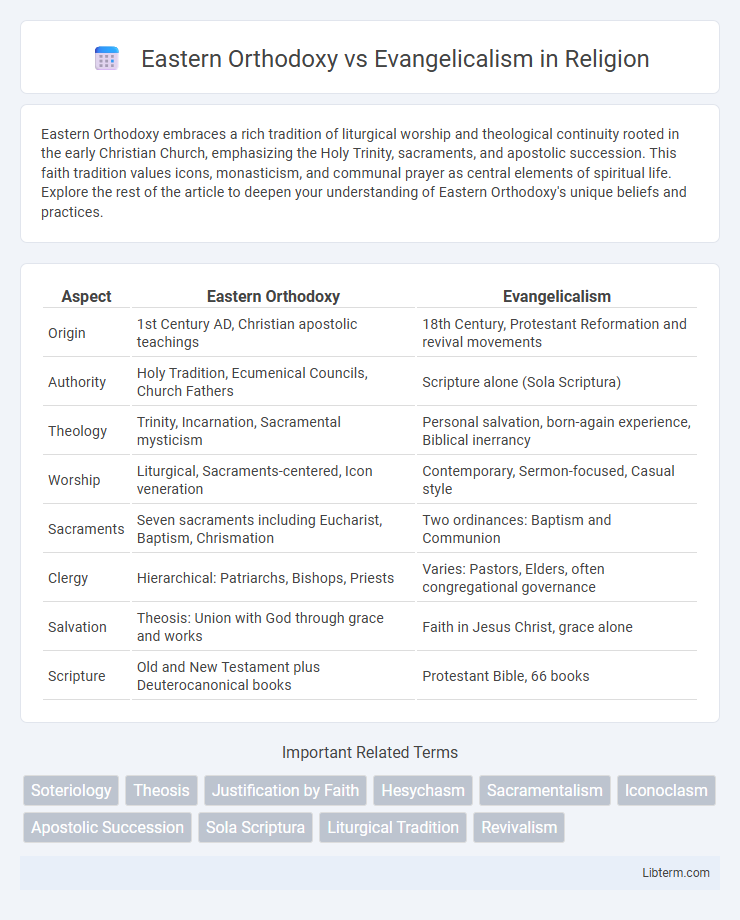Eastern Orthodoxy embraces a rich tradition of liturgical worship and theological continuity rooted in the early Christian Church, emphasizing the Holy Trinity, sacraments, and apostolic succession. This faith tradition values icons, monasticism, and communal prayer as central elements of spiritual life. Explore the rest of the article to deepen your understanding of Eastern Orthodoxy's unique beliefs and practices.
Table of Comparison
| Aspect | Eastern Orthodoxy | Evangelicalism |
|---|---|---|
| Origin | 1st Century AD, Christian apostolic teachings | 18th Century, Protestant Reformation and revival movements |
| Authority | Holy Tradition, Ecumenical Councils, Church Fathers | Scripture alone (Sola Scriptura) |
| Theology | Trinity, Incarnation, Sacramental mysticism | Personal salvation, born-again experience, Biblical inerrancy |
| Worship | Liturgical, Sacraments-centered, Icon veneration | Contemporary, Sermon-focused, Casual style |
| Sacraments | Seven sacraments including Eucharist, Baptism, Chrismation | Two ordinances: Baptism and Communion |
| Clergy | Hierarchical: Patriarchs, Bishops, Priests | Varies: Pastors, Elders, often congregational governance |
| Salvation | Theosis: Union with God through grace and works | Faith in Jesus Christ, grace alone |
| Scripture | Old and New Testament plus Deuterocanonical books | Protestant Bible, 66 books |
Introduction to Eastern Orthodoxy and Evangelicalism
Eastern Orthodoxy is a Christian tradition emphasizing continuity with the early Church, liturgical worship, and the Nicene Creed, with a hierarchical structure led by bishops and patriarchs. Evangelicalism centers on personal conversion experiences, the authority of Scripture, and active evangelism, often characterized by nonliturgical worship and autonomous church governance. Both traditions share core Christian beliefs but differ significantly in theology, worship practices, and ecclesial organization.
Historical Origins and Development
Eastern Orthodoxy originated in the Eastern Roman Empire, developing from the early Christian communities established in cities like Constantinople, Jerusalem, and Alexandria, and formally separated from the Roman Catholic Church during the Great Schism of 1054. Evangelicalism emerged much later, rooted in the Protestant Reformation of the 16th century, emphasizing personal faith, biblical authority, and evangelical outreach. The historical trajectory of Eastern Orthodoxy involves liturgical tradition and hierarchical continuity, while Evangelicalism emphasizes revivalism and missionary activity as key developmental factors.
Core Theological Beliefs
Eastern Orthodoxy emphasizes theosis, the process of becoming united with God through participation in the sacraments and the life of the Church, highlighting the continuity of Holy Tradition and the authority of Ecumenical Councils. Evangelicalism centers on the authority of Scripture alone (sola scriptura), the necessity of personal conversion or being "born again," and the belief in salvation by faith alone (sola fide) through grace. The Orthodox Church maintains a sacramental and mystical approach to salvation, while Evangelicalism stresses individual faith in Christ and the importance of evangelism and scripture exposition.
Authority: Scripture, Tradition, and Leadership
Eastern Orthodoxy emphasizes the harmonious authority of Scripture and Holy Tradition, upheld by the teaching authority of the Ecumenical Patriarch and bishops, viewing Tradition as a living transmission of apostolic faith. Evangelicalism centers on the supreme authority of Scripture alone (sola scriptura), often rejecting extra-biblical traditions, with leadership varying widely but frequently characterized by congregational or pastoral autonomy. The Orthodox model integrates Scripture, Tradition, and hierarchical leadership as coequal authorities, whereas Evangelicalism prioritizes biblical text and tends to decentralize ecclesiastical authority.
Worship Practices and Liturgy
Eastern Orthodoxy emphasizes a highly structured, ancient liturgy centered around the Divine Liturgy of St. John Chrysostom, featuring extensive use of icons, incense, chanting, and elaborate rituals that engage all senses. Evangelical worship practices prioritize simplicity, contemporary music, spontaneous prayer, and sermons aimed at personal conversion and direct communication with God. The Orthodox liturgical calendar includes numerous feasts and fasts integrated into worship, whereas Evangelical services are typically shaped by the sermon and often vary widely between congregations.
Sacraments and Ordinances
Eastern Orthodoxy emphasizes seven sacraments--Baptism, Chrismation, Eucharist, Confession, Marriage, Holy Orders, and Anointing of the Sick--viewed as means of divine grace essential for spiritual life. Evangelicalism typically recognizes two ordinances, Baptism and the Lord's Supper, regarded as symbolic acts of obedience rather than channels of grace. The theological distinction highlights Eastern Orthodoxy's sacramental theology rooted in mysticism versus Evangelicalism's focus on personal faith and scriptural authority.
Salvation: Faith, Works, and Grace
Eastern Orthodoxy emphasizes salvation as a synergistic process involving faith, grace, and works, viewing them as interconnected elements for spiritual transformation and union with God. Evangelicalism prioritizes salvation by faith alone, asserting that grace is a free gift from God received through faith, with good works seen as evidence rather than a means of salvation. Both traditions uphold grace as essential, but differ in the role and balance of faith and works within the salvation experience.
Role of Icons and Religious Art
Eastern Orthodoxy embraces icons as sacred windows to the divine, employing meticulously crafted religious art to facilitate worship and spiritual connection. In contrast, Evangelicalism generally emphasizes simplicity in worship spaces, often avoiding the use of icons or religious images to prevent idolatry, focusing instead on the preached Word and personal faith. The role of religious art in Eastern Orthodoxy serves as a theological and liturgical tool, while Evangelicalism prioritizes scripture and individual interpretation over visual representation.
Community Life and Church Structure
Eastern Orthodoxy emphasizes a hierarchical Church structure led by bishops and patriarchs, fostering communal worship through liturgical traditions and sacramental life within tightly knit parish communities. Evangelicalism tends to feature a more decentralized or congregational polity, highlighting personal faith expressions and small group fellowships that promote active community engagement and discipleship. Both traditions prioritize community life but differ in governance and worship style, shaping distinct spiritual and social experiences for adherents.
Contemporary Challenges and Future Trends
Eastern Orthodoxy faces challenges such as secularism, declining church attendance, and the need to address modern ethical issues while preserving ancient traditions. Evangelicalism grapples with political polarization, cultural shifts, and maintaining doctrinal purity amid rapid growth and diversification. Future trends indicate Eastern Orthodoxy may emphasize digital engagement and interfaith dialogue, whereas Evangelicalism could see increased emphasis on social justice and global mission expansion.
Eastern Orthodoxy Infographic

 libterm.com
libterm.com